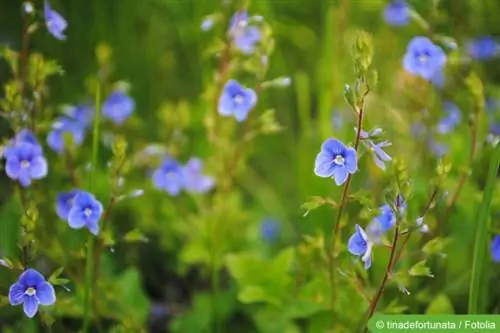- Author admin [email protected].
- Public 2023-12-17 03:39.
- Last modified 2025-01-24 12:45.
When the first early bloomers in the gardens and meadows delight the eye after winter, the germander speedwell (Veronica chamaedrys) with its bright blue flowers is one of the flowering plants in the garden that immediately stands out due to its color. Once the germander speedwell has found its place in the garden, it is not difficult to care for this plant because it is quite undemanding. However, there are a few points that need to be taken into account with regard to settlement and care so that the Germander speedwell can develop its full splendor.
A little information in advance: The germander speedwell is known by many different names. It is also commonly called, among other things, Men's Faithful, Wild Forget-Me-Not, Eyebright or Women's Bite and is a member of the plantain family.
Location
If Mannestreu is given a good location, it will develop very well. The plant loves a lot of light and sun and does not bloom at all in the shade. The germander speedwell can also thrive in partially shaded places, but it no longer blooms as profusely as in sunny places.
Spontaneous self-settlement
It happens that the Germander speedwell spontaneously settles in a garden because it reproduces both by sowing and by rhizomes and also grows wild in the wild on the edges of walls, field edges or in meadows. Incidentally, Veronica chamaedrys is not only a beautiful flowering plant, but is also a medicinal herb. The pretty flowers are edible and are used as a tasty decoration in various dishes. Anyone who plants this perennial in their garden is also doing the bees a favor, because the germander speedwell is also a nectar plant.
Planting
Usually the germander speedwell is not sown, but rather planted by dividing the perennials. It is best to plant the divided perennials for the first time in the summer months. Around four to five plants per square meter are planted at a distance of 30 to 40 cm. They develop quickly and soon form a dense carpet.
Sowing
Like all types of speedwell, it is also possible to propagate or create new Veronica chamaedrys by sowing. It is important to ensure that enough nutrients are added to the soil before sowing. The seeds are planted in the prepared soil in spring. It is important to know that speedwell is one of the light germinators and therefore must not be covered with soil. The seeds may only be pressed carefully into the ground. It is then important to exercise caution when watering so that the seeds are not washed away. Only the following year will the wild forget-me-nots sown in this way begin to bloom. But it's worth it, because flower carpets of this type created from seeds usually bloom particularly profusely in the coming spring.
Tip:
When creating the corner with germander speedwell, make sure to add color accents with other flowers. Yellow or white crocuses, daffodils, red tulips or even small conifers offer a beautiful contrast to the bright blue carpet of flowers.
Soil texture

Veronica chamaedrys is quite undemanding when it comes to the soil it needs. However, the soil should, if possible, be light, sandy, pH-neutral and not too poor in nutrients. It shouldn't be too dry either. It is therefore important to always water the Mannestreu plants sufficiently if it stays dry outside for a longer period of time so that they remain beautiful and can develop well. However, the plant cannot tolerate waterlogging.
Fertilization
The germander speedwell likes nutrient-rich soil. Therefore, it should always be provided with enough nutrients. This can be compost, for example, but it also tolerates horn shavings, guano, bone meal and inorganic mineral mixtures well and develops its full blooms every year with this diet.
Be careful with the flowers
When handling Men's Faith, make sure that the flowers fall off very easily when touched. By the way, this is where the name “Mäntreu” comes from. The flowers are therefore not suitable for picking and should be left alone when caring for them.
Care in autumn and winter
Gamander speedwell or women's bite, men's faithful or whatever it is called from region to region, is one of the hardy plants. It can usually even tolerate severe frost. The plants grow to a height of between 15 and 30 cm over the summer and can be cut back in the autumn so that they sprout again next spring. To make sure that the small perennials don't die in winter, you can also protect them with a little mulch. However, the layer should be light and not too thick so as not to suffocate the tender plants. In spring, it is important to ensure that the germander speedwell is freed from this protective layer in good time, because it sprouts very early and shows its first bright blue flowers in April.
Pests
Gamander speedwell can be affected by mildew.
Frequently asked questions
Where does Germander Ehrenpreis particularly come into its own?
Since Veronica chamaedrys does not grow very tall, it is well suited for planting in front gardens or rock gardens, but also displays its flowers beautifully in the front areas of perennial beds. In this case, however, it is important to ensure that the tall growing perennials should be placed further back.
Does male loy alty also develop well on a lawn in the garden?
Absolutely. Even in the wild, this plant likes to settle in pastures and meadows. It just needs the right soil and enough light and sun, then it often sows itself because insects, ants or the wind carry the seeds there. If you have a wild meadow in your garden that isn't constantly mowed down, germander speedwell will grow well here and be pleasing to the eye.
What you should know about germanders in brief
- The Germander honorary prize is also known as the faithful man, eyebright or wild forget-me-not.
- The plant is perennial, grows up to 30 cm high and flowers sky blue but with dark veins.
- The leaves of the plant are egg-shaped and opposite. They are short-stemmed or sit directly on the stem.
- The germander speedwell spreads like a carpet and is a shallow rooter.
- A peculiarity of the Germander speedwell is that the petals fall off very quickly after being picked.
- The Germander speedwell quickly forms carpet-like cushions.
- Its flowers are very popular with insects. The flowering period lasts from May to August.
- Unfortunately, the plant is often fought as a weed in gardens, especially when it appears on the lawn.
- Caution: The plant is poisonous!
Did you know
that the germander speedwell is also popularly known as the thunderflower? It was once believed that it bloomed particularly profusely in years with heavy thunderstorms, or that picking the plant brought thunderstorms on the horizon. Germander speedwell used to be used as a medicinal plant for liver, stomach and intestinal diseases.
Care
- The plant absolutely needs sun as much as possible. Without sun, no flowers form.
- The plant substrate should be medium dry to dry. Light, sandy, neutral but fertile soil is ideal.
- The germander speedwell is an indicator plant for loose, nitrogen-rich soil.
- The watering is moderate.
- Fertilization is carried out either with organic (compost, horn shavings, bone meal, guano) or inorganic (various minerals) fertilizer
- Do not plant more than 5 plants per square meter as the plant spreads well.
- Cut back in autumn and cover with mulch!
- The root ball should be divided every two to three years so that the abundance of flowers is not lost.
- The germander speedwell is propagated by division in autumn or by half-woody cuttings from non-flowering shoots.
- Mildew often occurs as a disease.
- Pests are rare.
Cutting
- Gamander speedwell is cut back in autumn.
- It will be mowed away on the lawn anyway.
- Cut off almost to the ground in the bed and cover.
- Pruning is often done in spring, before budding.

